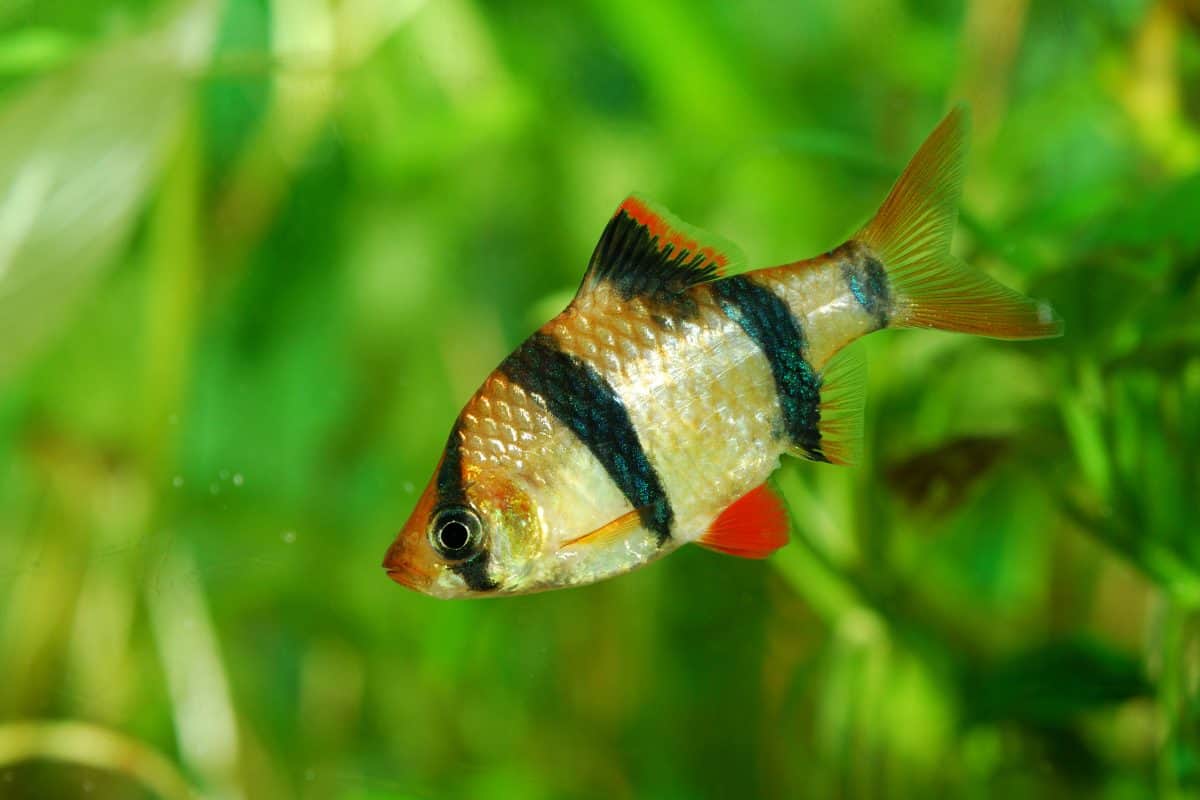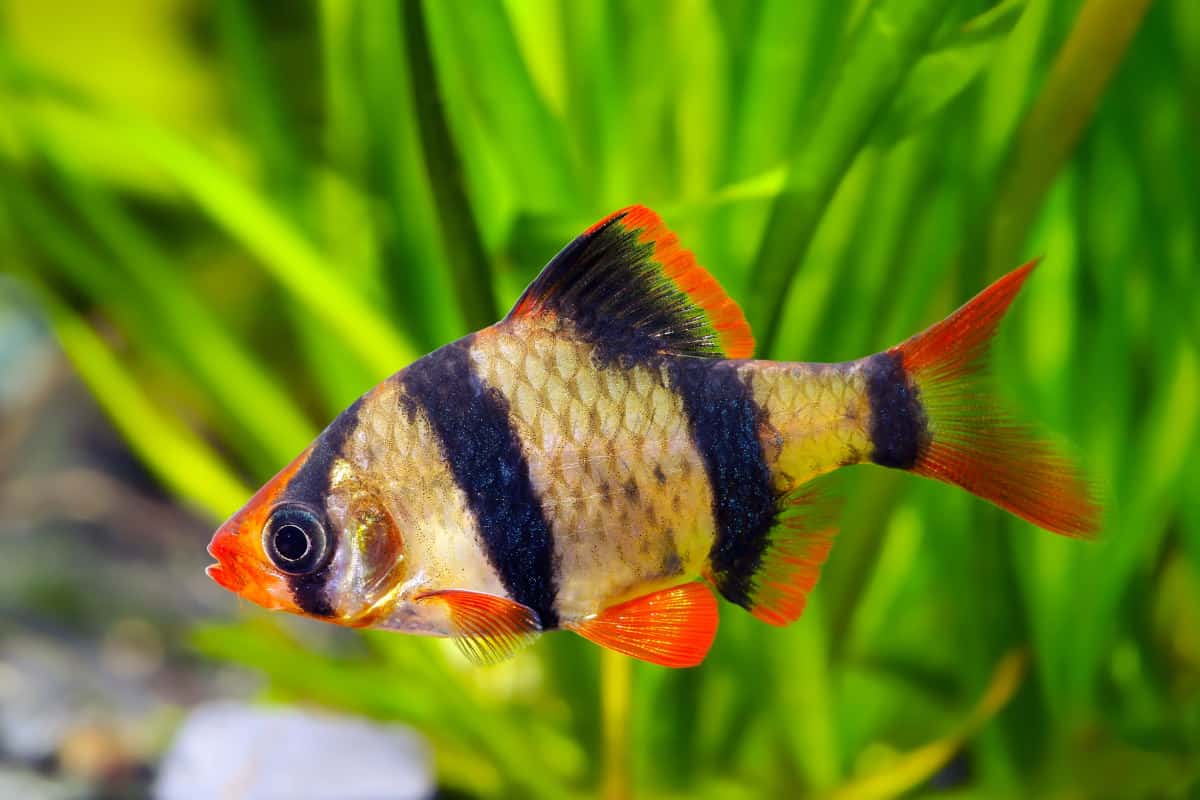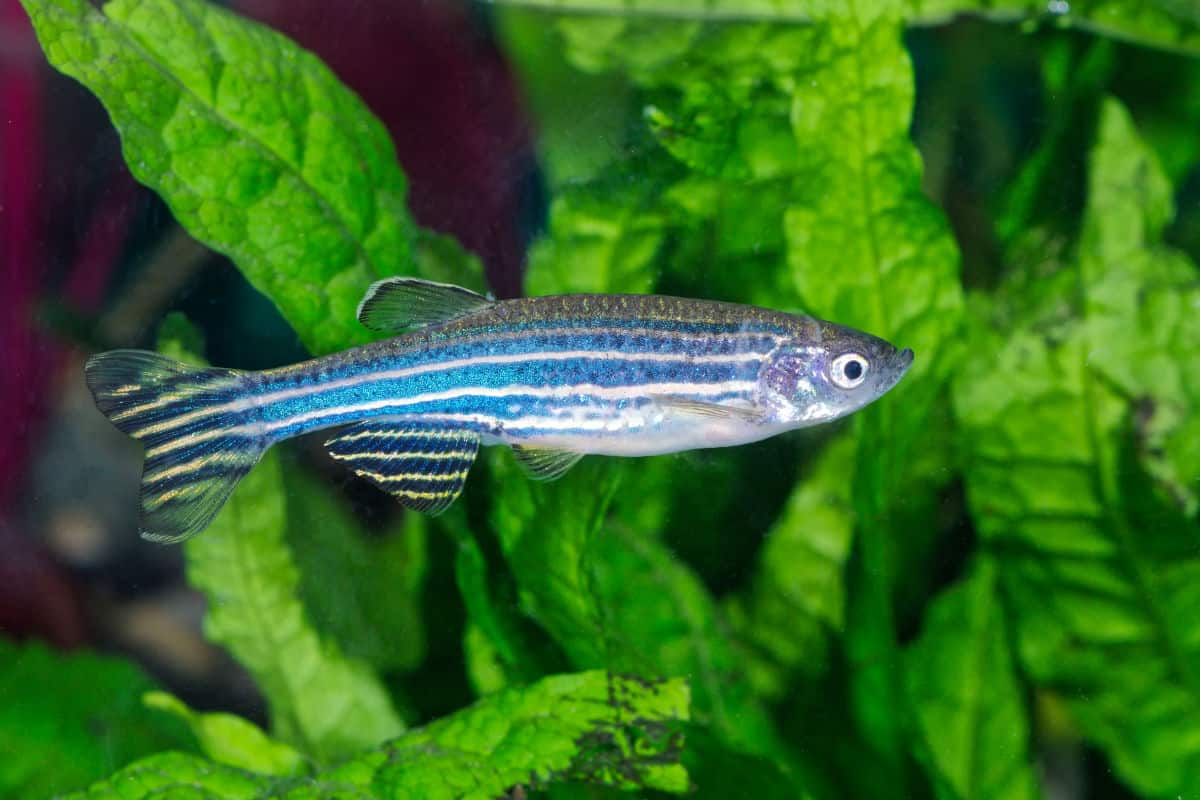In the following article on tiger barb care, we cover their care requirements and tank setup, and what you can expect when keeping them in your home aquarium.
The tiger barb is a common aquarium fish that likes to be kept in large schools. Active and attractive, they can be a great addition for a home aquarium.
Originally from Asia, they are frequently farm bred and readily available through your local fish supplier.
Tiger barbs are available in a variety of color forms and enjoy being kept with others of their kind. Though they can be aggressive and shouldn’t be kept with timid fish, they don’t need to be kept alone. In fact, it’s really in their best interest to keep them in a substantial school of fish.
They are a hardy species, relatively easy to care for and an excellent choice for a beginner, but will still provide plenty of enjoyment for an experienced hobbyist.
If you’ve been considering tiger barbs for your tank, you’ll want to know best practices to follow for their care.
Overview and Statistics
Before we get started, in this table you’ll find some useful information on their breed profile, as well as a summary of the main points of their care.
| Characteristic | Details |
|---|---|
| Common name(s): | Tiger Barb, Black Tiger Barb, Gold Banded Barb, Green Tiger Barb, Moosbarb, Partbelt Barb, Sumatra Barb, Sumatran Barb, Tiger |
| Scientific Name(s): | Barbus tetrazona, Capoeta tetrazona, Puntius tetrazona, Systomus sumatranus, Systomus sumatrensis, Systomus tetrazona |
| Family: | Cyprinidae |
| Origin: | Asia |
| Care Level: | Easy |
| Temperament: | Semi-aggressive |
| Adult Size: | 3 inches |
| Color Form: | Black, orange, white, yellow |
| Lifespan: | 5+ years |
| Minimum Tank Size: | 30 gallons |
| Typical Tank Setup: | Well planted with open swims |
| Tank Level: | All levels |
| Diet: | Omnivore |
| Water Conditions: | Freshwater, 74–79° F, KH 4–10, pH 6.0–7.0 |
| Tank mates / Compatibility: | Can be kept with other barbs and possibly cichlids—not recommended as a tank mate for peaceful community fish. Loaches, tetras, and gouramis can be successful. Fragile-finned or decorative-finned species should be avoided. Tigers are notorious fin nibblers. |
Tiger barbs are currently a quite popular addition to a home freshwater aquarium. Hobbyists enjoy their active lifestyle and the splash of color they add to a tank. They are a playful species and their antics provide fun viewing for both young and old hobbyists.
They are long living. If you provide a tank environment that suits them, you can expect to keep them for five to 10 years. To really allow them to thrive, though, you’ll need to plan on keeping a true school of them.
While not suited to being kept with slow-moving or timid fish, the tiger barb does well with other assertive species. Displays of dominance and hierarchical behavior are normal. You only need to make sure targeted fish aren’t being harassed into illness or poor condition.
They originated in Asia and thrive in tanks with plenty of open swims and live plants. They like clean, highly oxygenated water. They do well in tanks with significant lateral space, even if they aren’t overly deep.
Appearance

The tiger barb is a small species, maxing out at just three inches. They usually boast vivid colors and their trademark black striping. The traditional coloring involves red tips along the fins and nose. Their bodies are usually a silver color.
Recently, hobbyists have begun to selectively breed them for other color varieties. Now you can find green, black, and even albino colorations of the tiger barb. While some of these colorations no longer sport the namesake stripes, they are the same kind of fish and will interbreed if kept together.
It may be difficult to tell males and females apart from one another. Usually, females will be larger than males. The males will have better, more vibrant coloring than females. They often pair themselves off into breeding pairs, and this can help you identify your males and females.
Behavior and Temperament
The tiger barb is considered semi-aggressive. If kept with slow-moving species, they are likely to nip at their fins and bully them.
While they can be aggressive toward others, it’s essential to keep the tiger barb with other fish. These are a true schooling species and will not do well in tanks without any, or only a few, companions. They require the company of at least five other fish.
The tiger barb participates in normal displays of dominance. They do employ a hierarchy in their school, and you may see strange behaviors that indicate the social structure. These behaviors are entirely normal.
Submissive fish will frequently “stand on their heads” by tilting their heads toward the ground. You may also see them mouthing one another along their bodies. This behavior often continues until one cedes to the other and swims away.
If you do feel one of your fish is being targeted or harassed to the point of stress or illness, consider removing that fish from the tank. Allow it time to recover without being bothered and try a reintroduction at a later date.
Habitat and Tank Requirements
Providing proper tiger barb care begins with creating the right tank environment for them. Replicating their original natural environment is one of the best ways you can do that.
They are native to Asia and found in Sumatra, Borneo, and Malaysia. In the wild, their waters are filled with plants. They prefer highly oxygenated waters and do well with tanks that include driftwood and rocks.
The following information will help you provide the kind of home your tiger barbs can thrive in.
What Size Tank do Tiger Barbs Need?
They are quite a small species. Even keeping a small school doesn’t require a tremendous amount of space. However, these are active fish who love to swim. They need significant swimming space to be healthy and happy. This means you shouldn’t plan on keeping your barbs in less than a 30-gallon tank size.
Also, lateral swim space will be more important than depth. Especially if you’re maintaining a single-species tank, you can get away with long tanks even if they aren’t overly deep.
So try to provide a short (in height) but wide tank, allowing lots of side to side swimming room.
Water Type and Parameters
They are a freshwater fish, so need to be kept in a freshwater aquarium. They prefer well oxygenated and clean waters, so set up a good regular water change schedule. They also prefer slow-moving waters.
With this in mind, they do need filtration in their tank, but you should make sure your chosen filtration system doesn’t create too much in the way of currents in the water.
Ideal water conditions include temperatures between 74 and 79 degrees Fahrenheit, a KH level of 4–10, and a pH of 6.0–7.0.
What Substrate Should You Use?
A planted tank is strongly recommended, so you will want to invest in a nutrient-rich substrate, designed to grow and maintain significant greenery.
In its natural habitat, the tiger barb lives in tributaries that have plenty of sand and rock. Layering your substrate with these natural elements can help create a natural feeling and suitable home.
Filtration Requirements
Theys like their water to be very clean. For the healthiest fish, you’ll want to invest in a strong filtration system.
HOB, or ‘Hang-on-the-back’ filters are a great choice for these fish. This type of filter will keep your water parameters under control and lessen the amount of necessary water changes. You’ll want to choose a filter with reduced water flow, or adjustable flow, and don’t use one that’s made for a tank larger than you have, so you can keep water currenst down.
When maintaining a breeding tank, it’s recommended that you use a sponge filter instead. This will help prevent any loss of your small fry to the inlet of a powerful filter.
Lighting Requirements
It can be argued that tiger barbs have no specific light requirement. However, their preferred tank is one that’s heavily planted. With this in mind, we recommend they have their tank exposed to at least a moderate amount of lighting.
The types of plants you use will influence the lighting needs your tank has. Some people have reported their tiger barbs seem to hide from the light. If you find yours do this as well, using floating plants can help diminish light intensity.
LED lighting is highly recommended for your tank. LED lights consume less energy while giving off a good quality light without much heat. This will enable you to control the water temperatures better and provide a consistent, stable environment.
Plants, Decorations, Swims, And Open Spaces
Tiger barbs do best with plenty of plant life. This is a species that thrives in a heavily planted tank. Both floating and rooted plants will be appreciated.
Natural elements, like rocks and driftwood, are also great for a tank with tiger barbs. This helps emulate their natural environment and makes them feel safe and comfortable. They will enjoy swimming around and through obstacles, and do best where there are many open swims.
When creating your tank layout, make sure to balance your planted areas with your open swims. While they will enjoy zipping through and around plant matter, it’s very important there also be large stretches of swimmable space without obstacles.
How Many Tiger Barbs Can You Have Per Gallon?
If you are planning a single-species tank with only tiger barbs, you can keep one fish for every two gallons of water. Just remember to keep those open swim spaces and a tank that holds at least 30 gallons of water.
Should you be considering a multi-species tank, you will need to take into account the needs of the other tank inhabitants as well. A good rule of thumb is to allow one gallon of water for every inch of fish you have.
Work off their adult size to make sure you aren’t overcrowding the tank. If in doubt, always err on the side of underfilling rather than overfilling your preferred size aquarium.
Diet and Feeding

They enjoy an omnivorous diet. To provide the best care, you’ll need to plan on giving them a well-balanced diet that includes both plant and meat items. This most closely replicates their natural dietary behaviors and helps provide them with the necessary nutrients.
What do Tiger Barb Eat in the Wild?
In their natural habitat, they would have access to plants and meat-based proteins. They happily eat small insects, crustaceans, larvae, algae, and plants. There’s very little they come across they won’t consider eating if they’re able to.
What Can You Feed Them in Your Aquarium?
In your home aquarium, you should plan on providing commercially available fish food. Flake foods are an excellent choice to most of their needs.
You’ll also want to regularly provide them with baby brine shrimp (fresh or frozen) or bloodworms. This can help give them the meat protein they need to have in their rounded diet.
What Human Foods Can They Eat?
They do quite well when fresh vegetables are a part of their diet. This can provide some of the fiber they need, and keeps their diet interesting. Blanched zucchini and shelled peas are well-liked by tiger barbs and can be a real treat for them.
Don’t forget to remove any uneaten vegetables after a 24 hour period. It’s unlikely these vegetables will be eaten after this point and they may negatively impact your water parameters as they decompose.
How Often Should You Feed Them?
They do best when fed small amounts multiple times a day. Take care not to overfeed them as they can be quite gluttonous. Put out only what they can consume in two to three minutes and remove any uneaten food after that time.
While you should not overfeed your fish, you do need to make sure they are well-fed. Don’t skip meals—they may begin to hunt other tank inhabitants if it is hungry.
Do They Have any Special Care Requirements?
They are a hardy species, suitable for all skill levels.
It’s necessary for them to have access to plenty of swimming space and for them to be kept in schools. These aspects of their care are essential to their health and well-being.
While they are very resilient, they can be susceptible to Ich. Also called “white spot disease,” this illness is one of the most frequently seen in home aquariums. It’s a protozoan disease that usually makes its appearance when a fish is stressed, or its immune system is compromised.
While it’s best to try and prevent Ich altogether, there are treatments available. Should you notice any lesions or behavioral changes, seek medical care for your fish.
Compatibility With Other Fish and Tank Mates
They do very well with other species of barbs. They can be housed with some cichlids, though it’s best to avoid those that are extremely aggressive.
While tiger barbs do enjoy the company of other barbs, it’s generally recommended you avoid housing multiple color types together. These barbs will frequently interbreed and may produce fish with less desirable coloring.
Avoid housing your tigers with timid, peaceful community fish as they are known to be fin nippers, and timid fish will probably be harassed by them. You might also find fancy-tailed species, and those who are slow-moving are too great of a temptation for your tiger barb and should not be kept together.
Other school-oriented fish billed as semi-aggressive can be well suited to life in the same tnak. Gouramis, tetras, and loaches are good choices for cohabitating with tigers.
Can You Keep Multiple Tiger Barbs Together?

Yes, they absolutely must be kept with others of their kind in community tanks.
Plan on having no less than six at a time with each other. This will provide them with the school social structure they need in order to thrive.
Buying Tiger Barbs
They have become incredibly popular for keeping in home aquariums. Due to this popularity, they are readily available at almost all local fish stores, at an affordable price.
A young tiger barb can cost you as little as two dollars. Older, larger individuals may set you back a little bit more, but not by much.
When shopping for your fish in person, be aware that they can be vulnerable to Ich. The stress and overcrowding sometimes experienced in stores creates prime conditions for Ich. Avoid any specimens with white spots, dull coloring, or those who are listless and lethargic.
Never purchase a fish from a tank with dead fish in it or where other individuals look ill. There are many communicable diseases, and you don’t want to risk bringing something home to your personal aquarium.
If you’re unable to source one locally, they can readily be found and ordered via online sources. Tiger barbs are hardy and survive shipment well.
When you do bring your new fish home, remember to practice proper quarantine protocol before introducing them into your community tank. This can help you prevent exposing your existing fish and tank to any diseases that aren’t yet apparent in your new arrival.
Breeding Advice
They are fairly easy to breed. Once they have reached about an inch in length—usually between six and seven weeks of age—they are sexually mature and ready to reproduce.
While your fish may initiate reproduction on their own, it’s likely you’ll need to play an active role in seeing the eggs reach adulthood.
If you know you are planning to breed them, it’s always best to up their protein intake. Feed them more frequently and offer them high-quality foods. This is especially true for your females, as they will more readily lay eggs when in good condition.
Select your breeding pairs based on the vibrancy of their color. This is a trait you’ll want to pass along to the offspring. Separate them from the main tank and keep them in a breeding tank to ensure your stock is good.
Unlike many other species who choose a spawning site, the tiger barbs scatter their eggs throughout. Eggs will sink to the substrate and stick where they fall. Using marbles at the bottom of your breeding tank can help protect the eggs, falling into the larger gaps between if compared to a small gravel or sand.
Once the eggs have been laid, you will want to remove the adults from the breeding tank. They will eat the eggs if they’re allowed to remain with them.
In only 48 hours, your eggs will hatch. Your new fry won’t be free-swimming at first, but in just five days or so you can expect to see them swimming around the tank. Infusoria can be used to feed the new fry.
You will want to keep your fry separate from your adult fish until they are closer in size to the others, and therefore no longer vulnerable. Once that happens, you can introduce your baby fish to your main tank.
Interesting Facts and Trivia
- They eat according to their position in the school—if you can tell your individuals apart, you’ll notice they always eat in the same order.
- They will willingly interbreed with other types of barbs.
- They prefer to school with other fish who have similar coloration—clown loaches, flame tetras, and five-banded barbs all fit the bill.
- They are less likely to exhibit aggressive behaviors—like nipping at fins—when kept in large schools.
- Females can lay up to 1,000 eggs in a single day.
- They have a life expectancy of 5 to 7 years.
- Barbs are part of the carp family.
- Barbs are so called because they have barbels near their mouths—these are small sensory organs the fish use to help them taste.
- The earliest descriptions of the tiger barb date back to 1855.
- Sometimes referred to as freshwater sharks, these fish actually have rows of teeth.
Summary
The tiger barb can be a great addition to your tank. They are well-suited to both the beginner fishkeeper and those who have a lot of experience. They are hardy, playful, and fun to watch.
You’ll need to make sure you can provide them with a 30-gallon (or greater) tank and plenty of fish to keep them company. Other than that, remember to keep a strong filtration system in place, open swims, and plenty of plant life.
Tiger barbs can bring your tank to life—and bring you a lot of joy. We hope this article has taught you all you need to know, to make an informed decision on whether this fish for you, and how to provide the best possible care for them.
Have you kept tiger barbs? What’s your experience been with them? Did we miss anything here we need to include? Leave us a note in the comment section below.
Happy fish keeping!




